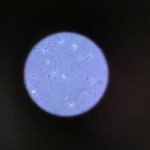Thirtieth celebration of the June 4, 1989 massacre on Tiananmen Square, taking place in front of the Chiang Kai-shek Memorial Hall in Taipei on June 4, 2019, with the presence of Hong Kong activists on stage. Photo by Filip Noubel, used with permission.
This article by Brian Hioe was originally published on Lausan, and is republished on Global Voices as part of a content-sharing agreement.
Editor’s note: “China” in this article, if unspecified, refers to the People’s Republic of China (PRC), excluding Hong Kong.
A 2019 concert by symphonic death metal band Chthonic drew 30,000 participants and featured a raucous moshpit in Taipei’s Liberty Plaza. It was also a political rally, with activists, legislators, and political candidates such as Chthonic frontman Freddy Lim and Lai Pin-Yu speaking about resisting the pro-Unification KMT party as a means to protect Hong Kong’s democracy. Many attendees responded with popular protest slogans “Restore Hong Kong, Revolution of Our Times” (光復香港,時代革命) and “Five Demands, Not One Less” (五大需求,缺一不可).
Such instances of public and creative support between Taiwan and Hong Kong have ramped up in the past year since the beginning of the anti-extradition bill protests. But we can also draw the line further back to understand the way in which Taiwan and Hong Kong are inextricably linked in their political past and future. Indeed, activists from both regions have long seen common cause in one another. Taiwan and Hong Kong both face threats to their democratic freedoms from the Chinese government. For years, activists have traveled between Taiwan and Hong Kong to observe or participate in protests and other significant political events. Extensive links between Taiwan and Hong Kong activists date back to well before the Sunflower and the Umbrella Movements in 2014. At that point in time, many ties developed through student groups that traveled between Hong Kong and Taiwan in the hopes of learning from each other.
Interactions between Hong Kong activists and Taiwanese activists involve the exchange of not just tactics, but also discourses, and conceptual framings of history and politics. Examining these exchanges can shed light upon the political self-understanding of both sides, as well as the prospects for building power between Taiwan and Hong Kong going forward.
‘Today Hong Kong, Tomorrow Taiwan’?
Activists in Taiwan and Hong Kong have frequently conceptualized the relation between the two places as temporal. The phrase “Today’s Hong Kong, Tomorrow’s Taiwan” (今日香港,明日台灣) has been a recurrent slogan on protest signs in Taiwan since the 2014 Sunflower Movement. What this phrase suggests is that Hong Kong represents a possible (bleak) future for Taiwan, if Taiwan loses its democratic freedoms. This would indicate that for Taiwanese, Hong Kong serves as a canvas onto which fears and anxieties regarding potential political outcomes for Taiwan are projected.
Political projections between Hong Kong and Taiwan go both ways. Taiwan is sometimes framed by Hongkongers in somewhat utopian terms in juxtaposition to Hong Kong regarding its legalization of gay marriage, functional state apparatus, or progressive politics. That is to say, Taiwan is sometimes posed as a lost historical possibility for Hong Kong, if history had gone differently—something of a desired future. However, the ways in which Hongkongers romanticize Taiwan and Taiwanese romanticize Hong Kong may be something that hinders genuine understanding of each local context.
Let’s consider the term “restore” (光復, guang-fu in Mandarin and gwong-fuk in Cantonese) in one of the most commonly seen—now banned—protest slogans “Restore Hong Kong, Revolution of Our Times” (光復香港,時代革命). The slogan suggests a temporal notion of “restoring” Hong Kong to a previous state, one that is preferable to the present. More broadly speaking, the term 光復 suggests reclaiming the past, but in a progressive way. Some have taken issue with the slogan’s suggestion that returning to Hong Kong as it was under British colonialism would be desirable. Hong Kong, after all, was hardly democratic under the British.
Yet the term 光復 is also a concept central to the KMT ideology, thus signaling strong Chinese Nationalist Party connotations. An unusually high number of streets and places in Taiwan are named 光復. They were renamed in the process in which the KMT, shortly after it came to Taiwan, renamed many places after its ideological tenets or sanctified party leaders. Here, the term 光復 refers to the ideological aim of the KMT to militarily retake the Chinese mainland from the CCP, as in “restoring” Mainland China (光復大陸).
But the term can also refer to the “restoring” of Taiwan (台灣光復) as a part of the Republic of China (ROC) after the KMT took control of Taiwan following Japan’s defeat in World War II, ending Taiwan’s Japanese colonial period and bringing the ROC government-in-exile to Taiwan. To this extent, the Xinhai Revolution (辛亥革命) is sometimes referred to as the Xinhai Restoration (辛亥光復), which suggests that the rise of the KMT-controlled ROC government and the fall of the Qing “restored” China, as in taking China back from the Manchus for Han Chinese.
Either way, this notion of “restoration” draws out the strong parallels between Taiwan and Hong Kong. The fact that some demonstrators in Hong Kong persist in waving British colonial flags at demonstrations suggests that they came to see the British colonial period in an overly rosy light after the 1997 Handover. Yet a similar phenomenon can be seen in Taiwan, in which the Japanese colonial period became an object of nostalgia for many Taiwanese after the KMT came to Taiwan.
These examples show that the entrance of a new colonial regime can cause people to romanticize a prior one. People’s discontent with the present conditions drives them to long for a past which, in many ways, never existed. Romanticizing the past can limit our political imagination as it confines our vision of what is possible and desirable now to a previous political order. Transformative possibilities predicated on actively seeking to establish a new political order are restricted by the notion of restoring the conditions of a previous order implied in the term 光復.
The use of the term 光復 in Hong Kong as part of 光復香港 has likely contributed to the appropriation of this KMT-charged term by members of the independence-leaning pan-Green camp in Taiwan. Most recently, the successful recall campaign led by progressive civil society groups against Kaohsiung mayor Han Kuo-yu of the KMT used as its slogan, “光復高雄”.
Translated into English as “Reset Kaohsiung” by campaign organizers WeCare Kaohsiung (WeCare 高雄) and the Citizens Mowing Action (公民割草行動), this was a somewhat subversive use of 光復. Rather than seeking a return to an a priori political order, it suggests a notion of wiping the slate entirely and beginning again. Perhaps this can be one way to reinterpret the phrase 光復香港 that does not entail nostalgia for British colonialism. Understood as “Reset Hong Kong” instead of “Restore Hong Kong,” 光復香港 calls for a radical re-imagination of Hong Kong’s future.
Yesterday’s Taiwan, Today’s Hong Kong?
The slogan “Today’s Hong Kong, Tomorrow’s Taiwan” suggests that Hong Kong lies somewhere in the temporal future for Taiwan, if Taiwan were to lose its democratic freedom. At the same time, some Hong Kong protesters have positioned the present events in Hong Kong in Taiwan’s temporal past.
There is an increasing use of the term “White Terror” (白色恐怖) in Hong Kong to refer to mass arrests, and reports of disappearances and mysterious suicides of individuals who have participated in demonstrations. But the “whiteness” of political terror is specific to Taiwan. As white is one of the KMT’s party colors, along with blue and gold, the “White Terror” refers to the decades of political repression carried out by the KMT during Taiwan’s martial law period, which was once the longest martial law period in the world.
Some have suggested that the worsening political conditions may lead to a wave of Hongkongers fleeing abroad, just as many Taiwanese activists fled overseas during the White Terror. As a result of this exodus, the Taiwanese diaspora eventually played an important role in Taiwan’s democratization—many speculate and hope the same may be the case for Hong Kong. In this way, these resonances give the “White Terror” of Taiwan’s past emotional resonance for Hongkongers’ in this new climate of terror, post-National Security Law.
However, in some ways, it is somewhat unusual that the term “White Terror” came to be used in Hong Kong. The White Terror carried out by the KMT was justified under the auspices of Cold War anti-communism, in which the KMT claimed that those it imprisoned and executed were Communist spies loyal to the Chinese Communist Party (CCP). By contrast, the CCP is precisely the political force that protesters in Hong Kong are contending with. Behind the actions of the Hong Kong government are the directives of the CCP from afar. Consequently, there is a certain irony that the term “White Terror” has come to be used instead of, say, “Red Terror”—though many of the individuals who have engaged in physical violence against demonstrators have worn white clothing during the attacks they carried out.
With the analogy to the White Terror in Taiwan, some political groups in Hong Kong have sought to use slogans from the Taiwanese democracy movement in Hong Kong. The recently dissolved Demosisto, for example, had adapted a variation of free speech martyr Deng Nan-jung’s slogan, “100% freedom of speech” (百分之百的言論自由), as “100% 自由”. Deng, the publisher of Freedom Era Weekly (自由時代週刊), self-immolated in April 1989 after a 70-day stand-off with the police while barricaded in the magazine’s offices.
Some protest actions have drawn from Taiwan’s more recent history of protest. During the attempted occupation of the Hong Kong Legislative Council on July 1, the words “Sunflower HK” were written on the wall of the legislative assembly chamber, referencing how the 2014 Sunflower Movement centered around the month-long occupation of the Taiwanese legislature.
Hong Kong has to contend with the direct presence of China in a way that Taiwan did not and does not.
Some in Hong Kong may even be seeking answers as to how to achieve self-determination in Taiwanese history. In an interview with The Reporter, Taiwanese activist Chiang Min-yen (江旻諺), who studied at the University of Hong Kong and has since become a link between Taiwan and Hong Kong social movements, mentions interest from Hongkonger friends in the works of 20th century Taiwanese Marxist revolutionary Su Beng (史明)—the so-called “father of Taiwanese independence”—and his theoretical elaborations of Taiwanese independence from a left-wing perspective. According to Chiang, interest in Su Beng’s work is from individuals advocating for Hong Kong self-determination but who wish to avoid the charge of nativism.
This is a telling anecdote regarding comparisons between Hong Kong and Taiwan. Posing present-day Hong Kong as comparable to Taiwan’s past, Hong Kong activists indicate their hopes that, like Taiwan, Hong Kong could eventually achieve democratization through social movement struggle. At the same time, conditions in present-day Hong Kong are not entirely analogous to Taiwan—primarily because of Hong Kong’s proximity to China.
Hong Kong has to contend with the direct presence of China in a way that Taiwan did not and does not, with regards to issues such as Chinese migration, or even the threat of military intervention. Hong Kong is separated from China by only a river, while Taiwan is separated from China by the Taiwan Strait. As Wu Rwei-ren, the Taiwanese anarchist theorist of national identity, points out in When Formosa Reclaims the World (受困的思想:臺灣重返世界), even if contemporary Taiwanese identity tends toward civic nationalism rather than ethno-nationalism, xenophobia against Chinese and ethno-nationalist sentiment would probably be significantly higher in Taiwan if Taiwan saw a level of Chinese immigration similar to that of Hong Kong.
Efforts to transcend ethno-nationalist views of China in Hong Kong will need to find some way to cope with this and Taiwan may not necessarily offer answers regarding how to avoid nativism—it may only be because of geographic contingency that Taiwan has managed to avoid conditions that lead to the emergence of strong nativism. Moreover, we should remember that civic nationalism can still evolve unpredictably into ethno-nationalism; there is never solely a “pure” form of civic nationalism which does not contain some elements of ethno-nationalism or vice versa.
Space as an obstacle to building power
Yet if activists in Taiwan and Hong Kong have conceptualized their relation to each other in a temporal fashion, it may be spatiality that constitutes the greatest obstacle to building power between activists of the two places at present.
Indeed, the roots of the present movement are deeply tied to contested juridical spatiality between Taiwan and Hong Kong. The controversial extradition bill that originally sparked the movement was proposed after Poon Hiu-wing was murdered in Taipei by her boyfriend Chan Tong-kai—both of whom were from Hong Kong. Chan could not be extradited to face charges because of Hong Kong’s lack of an extradition agreement with Taiwan. The Hong Kong government thus proposed an extradition bill that would have allowed the transfer of fugitives between Hong Kong and other places, including Taiwan and the PRC.
The case is reflective of how relations between Taiwan and Hong Kong are overdetermined by their respective juridical status and sovereignty. But despite these critical differences, both Hong Kong and Taiwan nevertheless share the “China factor,” which greatly shapes their political contexts. That the primary political cleavage in Taiwan is between the independence-leaning pan-Green camp and unification-leaning pan-Blue camp is, unsurprisingly, reminiscent of the split between pro-democracy groups and the pro-Beijing camp in Hong Kong. This is reflective of how local political issues are deeply tied up with the external question of the relation to China. To try and avoid the fundamental question of how Taiwan and Hong Kong relate to China may, in fact, limit our political imagination and possibilities for political action.
Protests in Hong Kong have seen a number of Taiwanese travel to Hong Kong in order to participate in demonstrations there. The start of the demonstrations in June 2019 and demonstrations around the time of Chinese National Day on October 1, 2019, saw particularly high numbers of Taiwanese activists traveling to Hong Kong to participate in demonstrations. As a result, in October 2019, there were reports of Taiwanese being searched at Hong Kong International Airport to check whether their luggage contained gas masks, helmets, or other protest equipment, with young men, in particular, being profiled.
Likewise, seeing the shortages of gas masks, helmets, and other protest supplies in Hong Kong, civil society and religious organizations in Taiwan undertook the task of sending protest equipment to Hong Kong. Some of these organizations were later involved in assisting or giving shelter to Hongkongers that sought refuge in Taiwan to avoid lengthy protest-related jail sentences.
At present, however, due to the COVID-19 pandemic, it has proven difficult for Taiwanese to travel to Hong Kong. Though Hong Kong’s borders remain open, Taiwanese who fly into Hong Kong to participate in protests will have to be quarantined for 14 days in Hong Kong and another 14 days in Taiwan when they return. As such, anyone who wishes to participate in demonstrations must be willing to sacrifice a month of their time in quarantine, something that anyone who needs a job to survive can hardly afford.
And with the passage of the National Security Law in Hong Kong, it is likely that supporters of Taiwanese independence would be targeted for sedition against the Chinese government. Taiwanese who enter Hong Kong could be targeted by the national security law, even Taiwanese who are simply transiting through Hong Kong International Airport. Last year, there was at least one case of a Taiwanese citizen who participated in demonstrations in Hong Kong being arrested after entering the Chinese mainland, and it is thought there could be other cases that have not yet come to light.
With countries already scrambling to attract members of the finance industry seeking to leave Hong Kong because of security concerns, it will be the business elites—who already travel at will between China, Hong Kong, and Taiwan—that can most easily secure residency in Taiwan through existing means. While movements in both Hong Kong and Taiwan have been accused of being bourgeois pro-capitalist movements, and Hong Kong and Taiwan have been accused of only fearing China because of the desire to protect free-market capitalism, those actually at the forefront of the movements in Hong Kong hardly have any means to escape.
With Taiwan’s borders shut to foreigners, it is not possible at present for Hongkongers to travel to Taiwan to seek asylum. After pressure from former Sunflower Movement activists such as DPP deputy secretary-general Lin Fei-fan, who likely broke with the party establishment to call for stronger measures to assist Hongkongers, the Tsai administration has set up an office to help Hongkongers in Taiwan obtain residency, study, find work, invest, or seek asylum in Taiwan.
Apart from providing assistance to Hongkongers seeking to work, study, or invest in Taiwan, the office will also handle asylum applications from Hongkongers. Survey polling seems to indicate that Taiwan is the top preferred destination for Hongkongers considering leaving Hong Kong. But though the office is based out of Taipei, rather than Hong Kong, there have been fears that there could be reprisals from the Hong Kong government against workers in Taiwan’s representative office in Hong Kong. Despite the opening of the new Taiwan office, however, there are few indications that the Tsai administration intends to pass legislation to set up a process for Hongkongers to have a formal process to apply for asylum in Taiwan, preferring to continue handling asylum seekers on a case-by-case basis.
Indeed, in Taiwan or elsewhere, issues regarding refugees often provoke anxieties regarding borders, and the notion of passing an asylum bill for Hongkongers has led to criticisms that this could allow for Chinese spies to mix in with Hongkongers to enter Taiwan. This is an absurd concern, given that many Chinese already live, work, and study in Taiwan, but this perhaps parallels how some Hongkongers have sought to exclude Chinese from “Yellow Circle” establishments and “Hongkongers only” restaurants.
In observing the exchange of political discourse between Taiwan and Hong Kong in the past few years, we can see that this has also involved the transfer of some elements of nationalistic discourse. The term “left plastic” (左膠), for example, imported from Hong Kong, has become used as a term to denigrate the political Left in Taiwan. Despite the term being of Hong Kong origin, ironically, the term has been used to denigrate members of the Taiwanese Left for being too concerned with lofty matters such as asylum for Hongkongers, rather than focusing on more practical national security concerns.
We should also note that students from Hong Kong, China, and Macau were only recently allowed to enter Taiwan again. Although foreigners with Alien Resident Certificates (ARCs) were allowed to enter Taiwan, the Republic of China includes Hong Kong, Macau, and the Chinese Mainland as part of its territory, as a result of which individuals from those places are not eligible for ARCs because they are not technically considered foreigners. Consequently, even with the COVID-19 situation under control in Hong Kong and many parts of China, travel from these areas to Taiwan was originally not permitted for months, something that was criticized as a discriminatory form of educational policy.
Regardless, even after the COVID-19 pandemic passes and Taiwan’s borders are reopened once again, the space for exchanges to occur between activists from Taiwan and Hong Kong—not to mention China—will become increasingly restricted.
A new era of repression, new avenues for connection
In his 2012 work, The Third View of China (第三種中國想像), Taiwanese theorist Wu Jieh-min once posed what seems in retrospect a rather utopian vision of activists in Taiwan, Hong Kong, and China uniting to combat their shared enemy—the CCP. Yet it has become harder for substantive exchanges to take place between activists from Taiwan, Hong Kong, and China, with travel to China blocked or increasingly dangerous for activists from Taiwan and Hong Kong.
The risk level of traveling to Hong Kong has risen sharply in the past year. The National Security Law is likely to severely escalate the level of risk for Taiwanese activists traveling to Hong Kong. And although the Taiwanese government may be willing to allow Chinese or Hongkongers into Taiwan and there remain some legal methods for Chinese activists to enter Taiwan despite the Chinese government’s ban on individual tourism to Taiwan, the Chinese and Hong Kong governments are liable to stop activists from leaving China or Hong Kong at the border.
It may be, then, that solidarity will increasingly have to take place at a distance in the future. Whether this is the case in the next year is yet to be seen. However, just as demonstrations in Hong Kong are expected to continue, political exchanges between Taiwan and Hong Kong are expected to continue to take place as well. But one question remains: How can activists in Taiwan and Hong Kong find ways to provide aid to each other apart from offering emotional support?
Activists in Taiwan and Hong Kong must dig deeper into our history of exchange and be attentive to the challenges in our present and future, to move beyond projection and into building power.
And a more fundamental question remains as to how to re-conceptualize the relation between Taiwan and Hong Kong in such a way that transcends the binary framing by which present-day Hong Kong is seen as resembling Taiwan’s authoritarian past or Hong Kong is viewed as a dystopian possible future faced by Taiwan. Both framings are, to borrow Theodor Adorno’s phrasing, “torn halves of an integral freedom, to which however they do not add up.”
In effect, in both framings, the relation between Taiwan and Hong Kong is one in which the other serves as a canvas on which to project political anxieties drawn from one’s own local context. The projection between Taiwan and Hong Kong, which has led to a sense of shared cause, has at its root cause the “Big Other” of China. In other words, the implicit contrast to China often forms the basis for comparing Hong Kong and Taiwan and in effect draws the boundaries around which we can imagine political action altogether. Neither negating the “China factor” nor being contained by that framework will be the great test for writers and activists in Taiwan and Hong Kong in the years to come.
What we should recognize in this path forward is that the political projection between Hong Kong and Taiwan is unlikely to lend itself to acts of transnational connection that are genuinely effective for building an international left. As the two regions are presented with ever narrower paths to liberation and an increasing certainty of repression, how to deal with the China factor will remain the cloud that looms over efforts to build transnational coalitions between Taiwan, Hong Kong, and beyond. We must, therefore, dig deeper into our history of exchange and be attentive to the challenges in our present and future, to move beyond projection and into building power.









